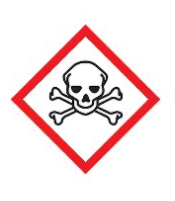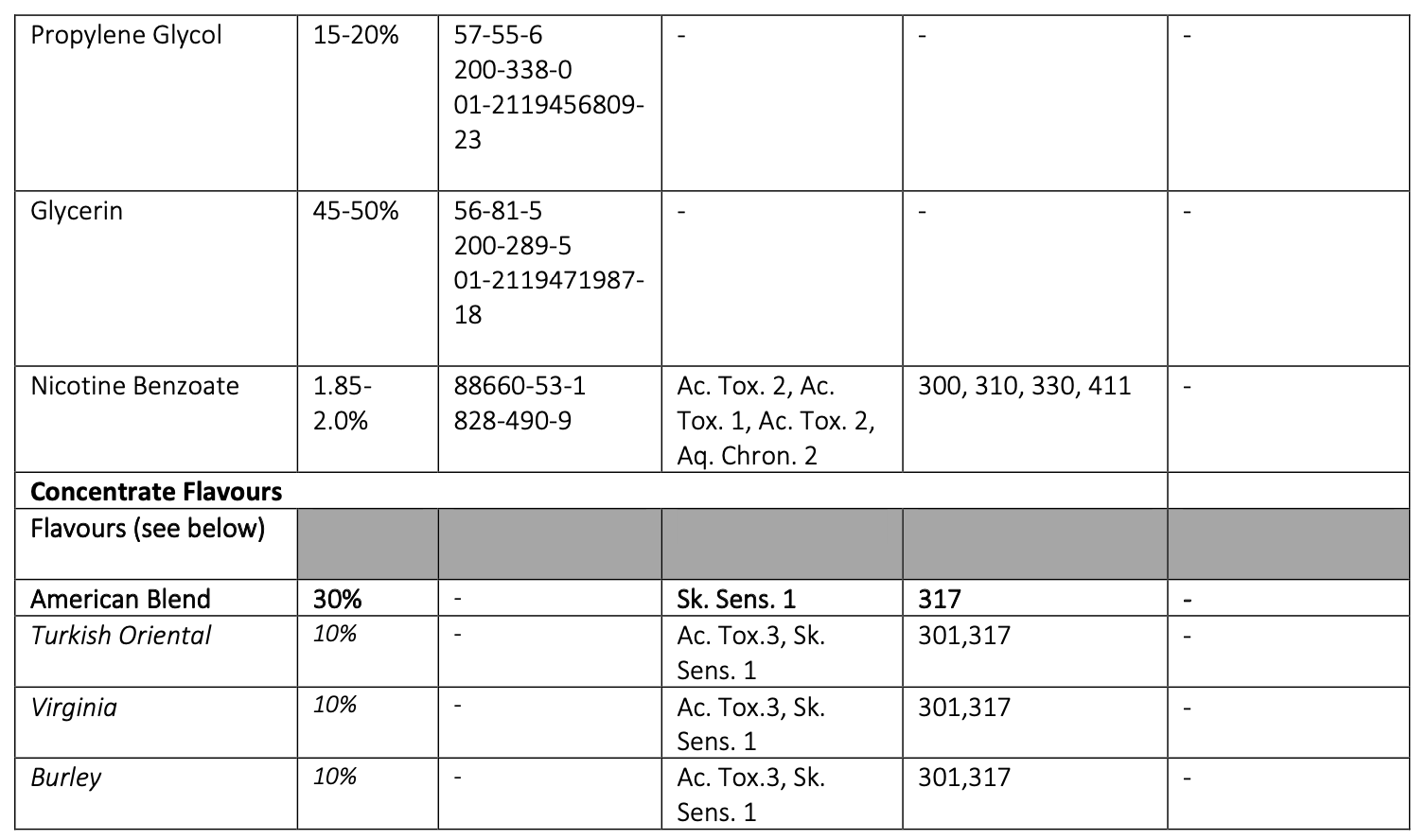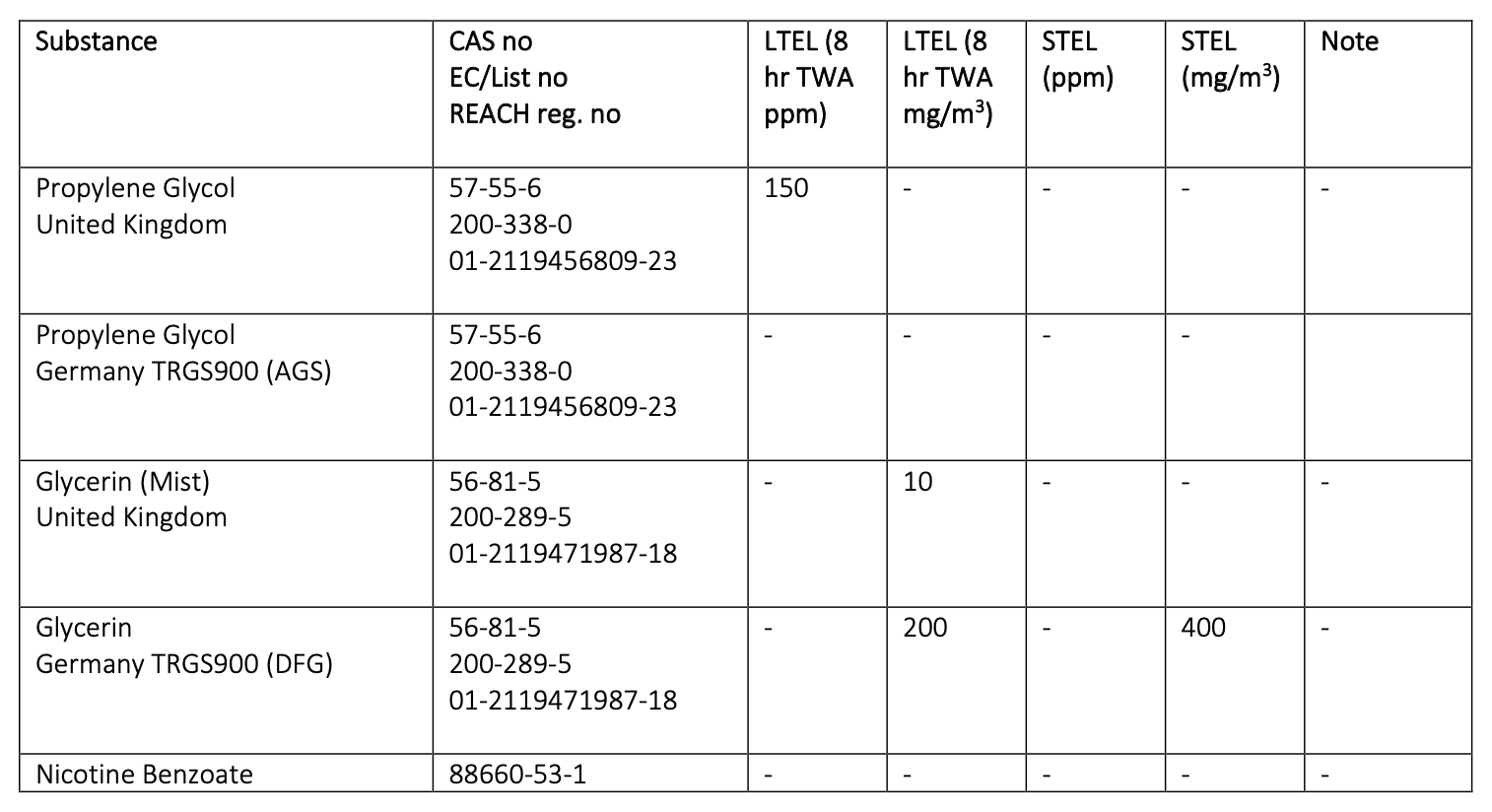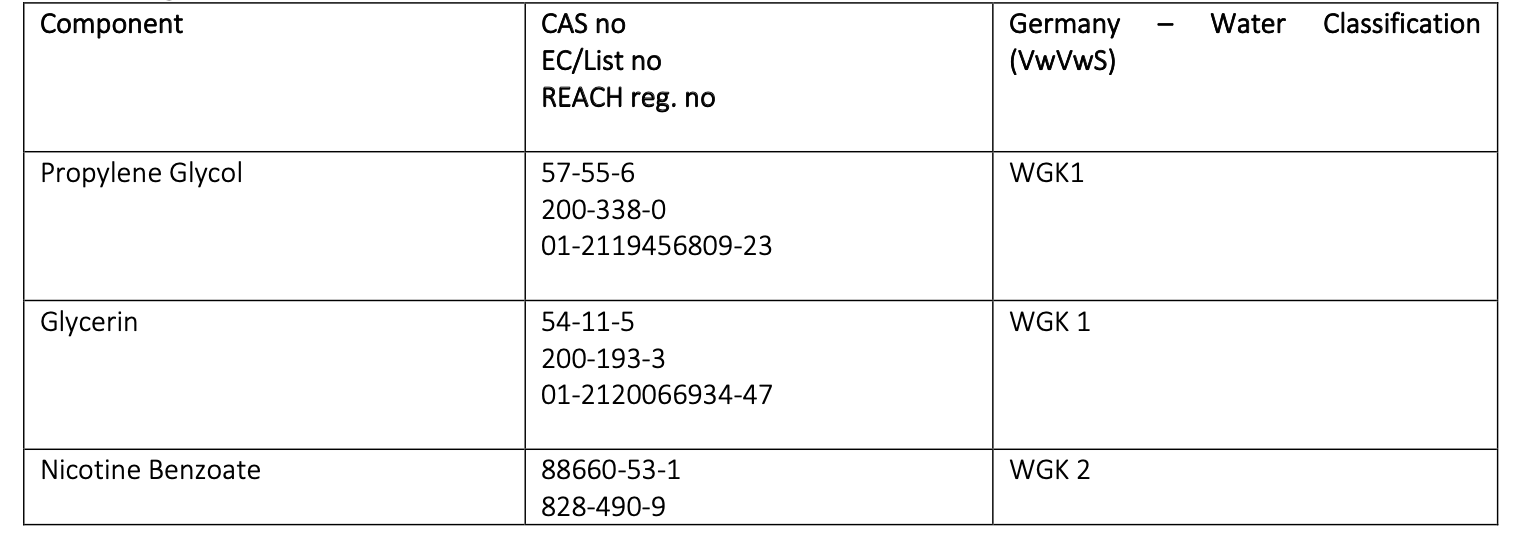MSDS Classic American
SAFETY DATA SHEET
1.1. Product Identifier
SAABI Classic American Tobacco 20mg E Liquid
1.2. Relevant identified uses of substance or mixture and uses advised against:
E-Vaping Liquid.
1.3. Details of supplier of the safety data sheet:
Supplier name: Aldama Labs UG
Supplier address: Landshuter Str. 55, Ergolding, Bavaria, Germany,
Telephone: 84030 (0049) 0871 14392314
Email:info@aldamalabs.com
1.4. Emergency telephone number
Telephone: (0049) 0871 14392314
Available: Out of working hours
SECTION 2: Hazards Identification
2.1. Classification of the substance or mixture
According to Regulation (EC) No. 1272/2008 (CLP) the mixture is classified as Acute Toxicity Oral Category 3 & Skin Sensitization Category 1.
2.2. Label elements
Pictogram(s):
Signal Word:
Danger
Hazard Classification:
Acute Toxicity Oral Category 3
Skin Sensitization Category 1
Hazard Statements:
H301: Toxic if swallowed
H317: May cause an allergic skin reaction.
Precautionary Statements:
P264: Wash hands thoroughly after handling.
P301+310: IF SWALLOWED – Immediately Call a POISON CENTRE, Doctor/Physician if you feel unwell.
P302 + P352: IF ON SKIN: Wash with plenty of water.
P330: Rinse mouth.
P501: Dispose of contents in accordance with local regulations.
2.3. Other hazards
None known
SECTION 3: Composition/Information on Ingredients
3.2. Mixtures
SECTION 4: First Aid Measures
4.1. Description of first aid measures
If ingested:
DO NOT induce vomiting. Never give anything to an unconscious person.
Rinse mouth with water. Get medical advice/attention should symptoms appear.
If on skin:
Immediately flush skin with plenty of soap and water whilst removing contaminated clothing. Seek medical attention if irritation persists.
If in eyes:
Immediately flush eyes (holding eyelids apart) with plenty of water for at least 15 minutes. Seek medical attention if irritation persists.
If swallowed:
Wash out mouth with water and then drink plenty of water or milk. Do not induce vomiting. Get medical attention.
If Inhaled:
Remove from exposure site to fresh air and keep at rest. If breathing has stopped give artificial respiration. Observe for possible delayed reaction. Get medical advice/attention if concerned.
Other first aid advice:
None known.
4.2. Most important symptoms and effects, both acute and delayed
If inhaled:
Following exposure to doses above permissible limits include stimulation of breath, nausea, vomiting, headache, dizziness, diarrhoea, tachycardia, increased blood pressure, sweating, salivation, burning sensation in the mouth, throat and stomach.
If on skin:
Can cause irritation, breathing problems, dizziness, cramps, nausea, vomiting. It can be absorbed through the skin. At sensitive individuals may experience an allergic reaction.
If in eyes:
Redness, tearing, mild irritation
If swallowed:
Nausea, vomiting. In extreme cases, after swallowing very large quantities of product, may appear breathing problems, dizziness, disorders of the respiratory tract.
4.3. Indication of any immediate medical attention and special treatment needed
Medical treatment:
Symptoms may not appear immediately. In case of accident or if you feel unwell, seek medical advice immediately (show the label or SDS where
possible).
SECTION 5: Firefighting Measures
5.1. Extinguishing media:
Suitable extinguishing media:
Water spray, foam, dry chemical or carbon dioxide.
Unsuitable extinguishing media:
Do not use water jet.
5.2. Special hazards arising from the substance or mixture
May produce carbon dioxide and carbon monoxide.
5.3. Advice for firefighters
Wear self-contained breathing apparatus and protective clothing. Cool down containers with water from safe distance to prevent bursting.
SECTION 6: Accidental Release Measures
6.1. Personal precautions, protective equipment and emergency procedures
Limit the access for the outsiders into the breakdown area, until the suitable cleaning operations are completed. In case of large spills, isolate the exposed area. Ensure adequate ventilation. Avoid contact with skin and eyes. Avoid contact with spilled material. Danger of slipping, do not passed through spilled material. Wear adequate personal protective equipment. Do not allow the product to get into mouth.
6.2. Environmental precautions
Prevent material entering drains and watercourses. Advise local authorities if spillage has entered watercourses and sewer.
6.3. Methods and material for containment and cleaning up
Provide adequate ventilation. Avoid excessive inhalation of vapours. Absorb onto inert material and transfer to suitable containers for disposal by a licensed waste contractor.
6.4. Reference to other sections
See Section 8 for protective equipment requirements. Appropriate conduct with waste product – see section 13. Personal protective equipment – see section 8.
SECTION 7: Handling and Storage
7.1. Precautions for safe handling
Handle in accordance with good occupational hygiene and safety practices. Avoid contact with skin and eyes. Do not inhale vapours. Ensure adequate ventilation. Before break and after work wash carefully hands. Keep not used containers tightly closed. Do not allow the product to get into mouth. Shake before use.
7.2. Conditions for safe storage, including any incompatibilities
Keep containers tightly closed in cool and well-ventilated area. Keep away from food, beverages or feed for animals. After opening seal the container and store in an upright position to prevent leakage. Avoid heat and ignition sources. Keep out of the reach of children.
7.3. Specific end use(s)
E-Vaping Liquid.
SECTION 8: Exposure Controls/Personal Protection
8.1. Control parameters
8.2. Exposure controls
Engineering controls:
Provide adequate ventilation.
Eye protection:
Safety glasses that are tested and approved under appropriate government standards – EN 166 (EU).
Face protection:
In case of normal and as intended use, no respirator is needed. If exposure limits are exceeded, apply face mask with appropriate organic vapour cartridge
Hand protection:
Nitrile gloves must be worn if handling large quantities. Gloves must be inspected prior to use. Use proper glove removal technique (without touching gloves outer surface) to avoid skin contact. Dispose of contaminated gloves after use in accordance with applicable laws and good laboratory practises. Wash and dry hands. The selected protective gloves must satisfy the specifications of EU Directive 89/686/EEC and the standard EN 374 derived from it. Please observe the instructions regarding permeability and breakthrough time which are provided by the supplier of the gloves. Ensure gloves are suitable for the task: Chemical compatibility, Dexterity, Operational conditions, User susceptibility, e.g. sensitisation effects, also take into consideration the specific local conditions under which the product is used, such as the danger of cuts, abrasion.
Skin Protection:
Long sleeved clothing. Overalls must be worn when handling large quantities.
Other protection:
None required.
Respiratory protection:
If ventilation is insufficient, wear respiratory protection. When workers are facing concentrations above the exposure limit, they must use appropriate certified respirators. To protect the wearer, respiratory protective equipment must be the correct fit and be used and maintained properly
Thermal hazards:
None known.
Environmental controls:
See Section 6.2
SECTION 9: Physical and Chemical Properties
9.1. Information on basic chemical and physical properties
Appearance: Dark Liquid.
Odour: Characteristic of associated flavorings.
Odour threshold: Not determined.
PH: Not determined.
Melting/freezing point: Not determined.
Initial boiling point: Not determined.
Boiling range: Not determined.
Flash point: Not determined.
Evaporation rate: Not determined.
Flammability: Not determined.
Decomposition temperature: Not determined.
Viscosity : Not determined.
Upper explosive limit: Not determined.
Lower explosive limit: Not determined.
Vapour pressure: Not determined.
Vapour density (Air=1): Not determined.
Relative density: Not determined.
Solubility: Soluble in water.
Partition coefficient: Not determined.
Auto ignition temperature: Not determined.
Oxidizing properties: Not determined.
Explosive properties: Not determined.
9.2. Other information
Not available.
SECTION 10: Stability and Reactivity
10.1. Reactivity: Stable.
10.2. Chemical stability: Stable.
10.3. Possibility of hazardous reactions: Possible reactions with nitric acid, sulphuric acid and oxidising agents
10.4. Conditions to avoid: Avoid high temperature, humidity and strong sunlight.
10.5. Incompatible materials: Zinc, strong oxidising agents.
10.6. Hazardous decomposition products: Carbon monoxide and unidentified organic compounds maybe formed during combustion.
11.1. Information on toxicological effects
Acute toxicity: LD50 (oral, rat) > 2,000 mg/kg – Propylene glycol, LD50 (dermal, rabbit: > 5,000 mg/kg – Propylene glycol
Potential health effects of pure nicotine benzoate:
Inhalation: May be harmful if inhaled. May cause respiratory tract irritation.
Ingestion: May be fatal if swallowed.
Skin: May be fatal if absorbed through skin. May cause skin irritation.
Eyes: May cause eye irritation.
Signs and Symptoms of Exposure:
Prolonged or repeated exposure can cause vomiting, diarrhoea, convulsions, cyanosis.
Teratogenicity:
May cause harm to the unborn child. May cause adverse reproductive effects.
Potential health effects of mixture:
Skin corrosion/irritation: May irritate skin.
Serious eye damage/irritation: May irritate eyes.
Respiratory or skin sensitisation: Some flavours may cause sensitisation by skin contact.
Germ cell mutagenicity: Data not available.
Carcinogenicity: Data not available.
Reproductive toxicity: Data not available.
STOT-single exposure: Data not available.
STOT-repeated exposure: Data not available.
Aspiration hazard: Data not available.
11.2. Other information
None known.
SECTION 12: Ecological Information
12.1. Toxicity
Propylene Glycol:
Toxicity to fish: LC50, Oncorhynchus mykiss/LC50 (96 h) > 100 mg/l
Aquatic invertebrates: OPP 72-2 (EPA-guideline) Daphnia Magna/EC50 (48 h) > 100 mg/l – Literature data, Micro-organisms/effect on activated sludge DEV-L2 > 5,000 mg/l
Inhibition of degradation activity in activated sludge is not to be anticipated during correct introduction of low concentrations.
12.2. Persistence and degradability: Data not available.
12.3. Bioaccumulative potential:Data not available.
12.4. Mobility in soil: Data not available.
12.5. Results of PBT and vPvB assessment: Data not available.
12.6. Other adverse effects: None known.
SECTION 13: Disposal Considerations
13.1. Waste treatment methods
Disposal methods for the product: disposal in accordance with the local legislation. Store remainings in original containers. Do not empty into drains.
Disposal methods for used packing: reuse/recycling/liquidation of empty containers dispose in accordance with the local legislation. Do not dispose empty packing with regular household waste. Do not mix with other waste. Legal basis: Directive 2008/98/EC, 94/62/EC.
SECTION 14: Transport Information
14.1. UN number
UN3144
14.2. UN proper shipping name
NICOTINE PREPARATION, LIQUID, N.O.S. (contains nicotine benzoate). (3-(N-methyl-2-pyrrolidinyl)pyridine, nicotine (ISO))
14.3. Transport hazard class (es)
6.1
14.4. Packing group
III
14.5. Environmental hazards
Unknown.
14.6. Special precautions for user
See section 2.
14.7. Transport in bulk according to Annex II of MARPOL73/78 and the IBC code
N/A.
SECTION 15: Regulatory Information
15.1. Safety, health and environmental regulations/legislation specific for the substance or mixture
National Regulations
INSERT TABLE HERE
This product contains nicotine which is a highly addictive substance as stated in the Tobacco Products Directive (2014/40/EU).
15.2. Chemical safety assessment
Not available.
SECTION 16: Other Information
16.1. Reason for change
N/A
16.2. Sources of information
Ingredient safety data sheet(s), C&L Inventory, GESTIS Substance Database and REACH Dossiers.
16.3. Full text of H phrases from Section 3
N/A
16.4. Method of evaluation
Hazards for mixture calculated in accordance with Regulation (EC) No. 1272/2008 (CLP) using the information provided for constituents (ingredients).
* Abbreviations and Acronyms:
CAS: Chemical Abstracts Service
WEL: Workplace Exposure Level
RPE: Respiratory Protective Equipment PBT: Persistent, Bioaccumulative, Toxic LTEL: Long Term Exposure Limit
STEL: Short Term Exposure Limit
LC50: Lethal Dose 50%
EC50: Effective Concentration 50%
vPVB: Very persistent, very bioaccumulative WGK nwg: Non-water polluting substance WGK 1: Slightly water polluting substance WGK 2: Water polluting substance
WGK 3: Highly water polluting substance
H300: Fatal if swallowed
H310: Fatal in contact with skin
H317: May cause an allergic skin reaction
H330: Fatal if inhaled
H411: Toxic to aquatic life with long lasting effects
Note: The above information is based on the data of which we are aware and is believed to be correct as of the data hereof. Since this information may be applied under conditions beyond our control and with which may be unfamiliar and since data made available subsequent to the data hereof may suggest modifications of the information, we do not assume any responsibility for the results of its use. This information is furnished upon condition that the person receiving it shall make his own determination of the suitability of the material for his particular purpose.






